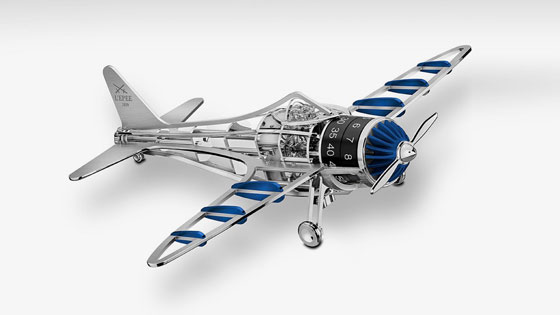
With Time Flies, L’Epée 1839 allows the imagination to soar through the skies.
This creation follows the interstellar adventures of Starfleet Machine and The 5th Element, exploring the solar system with Destination Moon, and excursions through the lower atmosphere with The Hot Air Balloon.
Time Flies pays tribute to the conquest of the skies and one of the most brilliant inventions ever made: the airplane. Aviation made its mark on the last century, motivating adventurers to go ever higher and ever further, and it changed travel forever. The plane captured the collective imagination, and there have been many stories of heroic aircraft journeys.
This creation is a partnership between l’ECAL (University of Art and Design Lausanne) and L’Epée 1839, embodying the adventurer’s airplane of our childhood dreams. Hours and minutes are displayed on large-diameter stainless steel discs with black PVD coating on a circular-brushed satin finish and stamped numerals. A quick glance is enough to read the time thanks to the excellent legibility of its display, but the spectacular skeletonised movement is worthy of deeper contemplation. The movement, built specifically for Time Flies, allows the escapement, which regulates precision, to be displayed in the cockpit. Accuracy is in the pilot’s seat!
The architecture of the 8-day movement, developed in-house by L’Epée 1839, follows the form of a real aircraft. As in a plane, power comes from the front where the engine is located, and is generated by a fully openworked crown reminiscent of engine cooling radiators just behind the propeller. When fully wound, this creation can soar for a full eight days before refueling. An airplane’s control and instrumentation systems are located within the cockpit; and the same is true for Time Flies, which has a horizontal precision regulator in its cockpit, just above the wings. This mechanism draws the gaze thanks to its constantly oscillating balance, and is protected from both cosmic radiation and curious fingers by a series of sma ll panels forming the cockpit’s cage.
June 24, 2021


 News
News